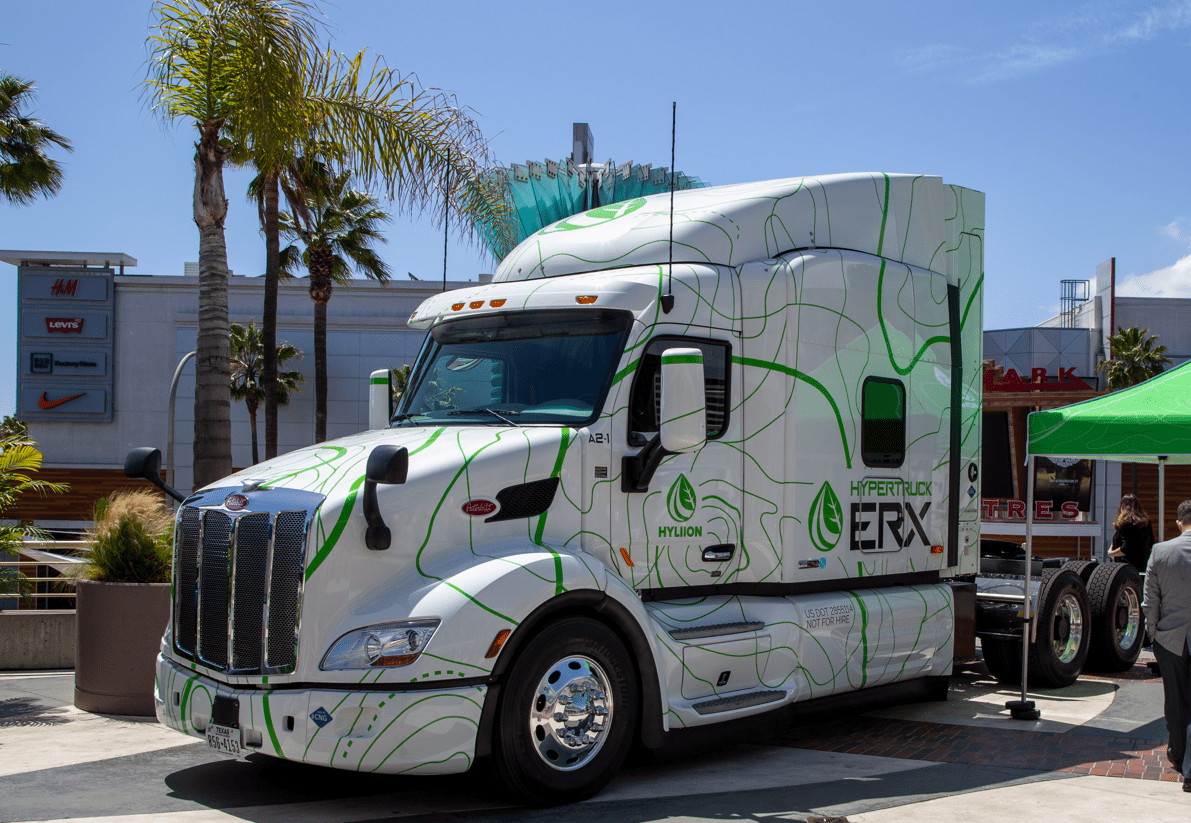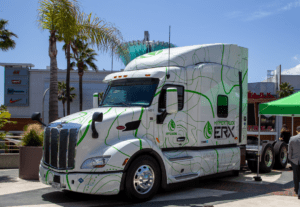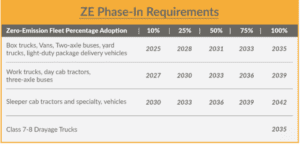

The electric vehicle transition is happening right before our eyes and California is leading the charge. The California Air Resources Board (CARB) is close to finalizing the Advanced Clean Fleets (ACF) regulation which means that mass electrification is on the horizon. The goal of this public policy will be to transition California’s entire fleet of medium- and heavy-duty trucks to zero-emission by 2045, where feasible. Although 2045 seems far into the future, companies with over $50M in gross annual revenue or fleets of 50 or more vehicles with a gross vehicle weight rating (GVWR) greater than 8,500 pounds are considered “high priority” fleets. Some fleets have compliance dates starting as early as 2025.
See the chart below for zero-emission phase-in requirements for different kinds of work trucks, tractors, and buses:

See the table below to understand how the proposed ACF regulation will make progress towards meeting public health and climate goals by reducing nitrogen oxides, fine particulate matter, and carbon dioxide from the air. Table courtesy of CARB.
Table 1: Proposed ACF’s cumulative total emissions reductions from 2024 to 2050 relative to the Legal Baseline

As of November 2022, the regulation is still being developed and is subject to change depending on public input and California Air Resources Board direction. However, the time to start electrifying is now.
Where the ACF regulation focuses on the operators of transportation fleets, the Advanced Clean Truck (ACT) regulation has two components including a manufacturer sales requirement, and a reporting requirement. The ACT requires manufacturers who sell MD/HD vehicles to sell zero-emissions vehicles as an increasing percentage of their annual sales from 2024 to 2035. The proposed ACF regulation and ACT regulation are complementary and are a part of CARB’s wider strategy to deploy medium- and heavy-duty zero-emission vehicles (ZEVs) everywhere feasible.
Both the ACT and ACF support California Governor Gavin Newsom’s executive order N-79-20 which states “Medium- and heavy-duty vehicle regulations requiring increasing volumes of new zero-emission trucks and buses sold and operated in the State towards the target of 100% of the fleet transitioning to zero-emission vehicles by 2045 everywhere feasible and for all drayage trucks to be zero emission by 2035.”
Currently, according to a Consumer Reports report, electric vehicles can require 10% to 40% more upfront capital to purchase than an internal combustion engine counterpart. However, zero-emission vehicles generally have lower operating costs than internal combustion engine (ICE) vehicles because they have lower maintenance costs. The lower maintenance costs can offset the initial higher purchase price over time. “As components and battery prices fall and technology continues to improve, the total cost of ownership is expected to become more favorable,” states CARB.
According to Alternative Fuels Data Center, electric vehicles typically require less maintenance than conventional ICE vehicles because:
To offset the initial cost to purchase an EV fleet, various grants and funding opportunities are available in California, Oregon, and Washington. Federal funding is also available.
Zero-emission trucks of all classes are becoming increasingly available as original equipment manufacturers (OEMs) rush to meet demand.
According to CARB, Zero-emission truck availability (as of July 2022) was:
Data collected in 2021 shows that the vast majority of trucks including yard tractors, refuse trucks, cargo vans and other types of trucks drive 100 miles or fewer per day. This means the mileage range of electric trucks should accommodate most commercial purposes. According to CARB, “medium- and heavy-duty ZEVs that are commercially available today are already capable of meeting the daily needs of most local and regional trucking operations and a variety of vocational uses.”
According to CARB, the proposed Advanced Clean Fleets regulation includes an exemption for cases in which a ZEV that meets the fleet’s needs is not available for purchase.
The zero-emission technology inventory (ZETI) tool from Global Drive to Zero allows users to compare worldwide commercially available offerings of zero-emission medium- and heavy-duty vehicles. For example, you can compare electric vehicle models from Bollinger Motors, Kenworth and Peterbilt and look at range, payload, energy capacity, first available year, and incentives, such as HVIP.
In many cases, a fleet owner may have little to zero net electricity cost after Low Carbon Fuel Standard credits are included.
The Low Carbon Fuel Standard (LCFS) encourages the decrease of the carbon intensity in California’s transportation fuel pool and provides an increasing range of low-carbon and renewable alternatives. It also encourages the use of cleaner low-carbon transportation fuels and the production of those fuels, therefore decreasing petroleum dependence in the transportation sector as well as achieving the air quality benefits that the Advanced Clean Fleets Regulation also aims for.
The LCFS is NOT funded publicly through tax dollars. This program operates as an open market where clean fuels, like electricity, generate credits and fossil fuels generate deficits. The funding of these programs comes from regulated entities which need to purchase the credits in order to operate in the state. Businesses operating electric equipment generate credits which are transacted and paid out quarterly.
The LCFS has multiple benefits for businesses subject the Advanced Clean Fleets regulation:
The best time to start on fleet electrification is now. To get an idea of where to begin transition planning, see our electrification road map.
The roadmap includes four steps:
Have questions about the Advanced Clean Fleets regulation, The Low Carbon Fuel Standard, your electrification timeline, or Original Equipment Manufacturers (OEM) that could equip your fleet? Don’t hesitate to contact us today.